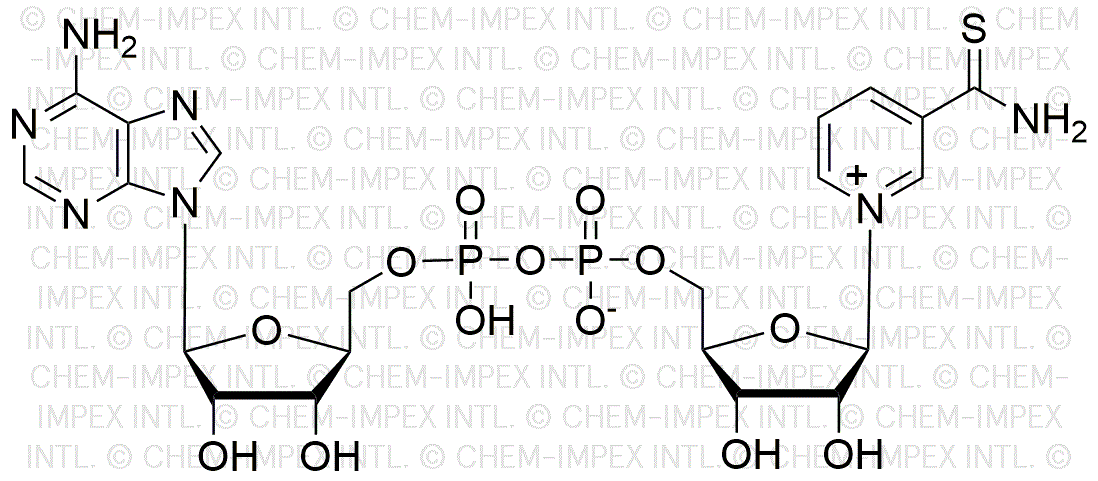Thionicotinamide adenine dinucleotide oxidized form is widely utilized in research focused on:
- Biochemical Pathway Studies: This compound is essential for studying metabolic pathways, particularly in cellular respiration and energy transfer, allowing researchers to understand how cells produce energy.
- Enzyme Activity Assays: It serves as a cofactor in various enzymatic reactions, making it invaluable for assays that measure enzyme kinetics and activity, especially in the fields of biochemistry and molecular biology.
- Drug Development: In pharmaceutical research, it aids in the development of new drugs targeting metabolic disorders by providing insights into the mechanisms of action of potential therapeutic agents.
- Cell Signaling Research: The compound plays a role in cell signaling pathways, helping researchers investigate how cells communicate and respond to external stimuli, which is crucial for understanding diseases like cancer.
- Antioxidant Studies: It is used in research focused on oxidative stress, allowing scientists to explore its potential protective effects against cellular damage, which is relevant in aging and neurodegenerative diseases.
Informations générales
Propriétés
Sécurité et réglementation
Applications
Thionicotinamide adenine dinucleotide oxidized form is widely utilized in research focused on:
- Biochemical Pathway Studies: This compound is essential for studying metabolic pathways, particularly in cellular respiration and energy transfer, allowing researchers to understand how cells produce energy.
- Enzyme Activity Assays: It serves as a cofactor in various enzymatic reactions, making it invaluable for assays that measure enzyme kinetics and activity, especially in the fields of biochemistry and molecular biology.
- Drug Development: In pharmaceutical research, it aids in the development of new drugs targeting metabolic disorders by providing insights into the mechanisms of action of potential therapeutic agents.
- Cell Signaling Research: The compound plays a role in cell signaling pathways, helping researchers investigate how cells communicate and respond to external stimuli, which is crucial for understanding diseases like cancer.
- Antioxidant Studies: It is used in research focused on oxidative stress, allowing scientists to explore its potential protective effects against cellular damage, which is relevant in aging and neurodegenerative diseases.
Documents
Fiches de données de sécurité (FDS)
La FDS fournit des informations de sécurité complètes sur la manipulation, le stockage et l’élimination du produit.
Spécifications du produit (PS)
Le PS fournit une description complète des propriétés du produit, notamment sa composition chimique, son état physique, sa pureté et les exigences de stockage. Il détaille également les plages de qualité acceptables et les applications prévues du produit.
Certificats d'analyse (COA)
Recherchez des certificats d'analyse (COA) en saisissant le numéro de lot du produit. Les numéros de lot et de lot se trouvent sur l'étiquette d'un produit, après les mots « Lot » ou « Lot de fabrication ».
Numéro de catalogue
Numéro de lot/série
Certificats d'origine (COO)
Ce certificat d'exploitation confirme le pays dans lequel le produit a été fabriqué, et détaille également les matériaux et composants utilisés et s'il est issu de sources naturelles, synthétiques ou autres sources spécifiques. Ce certificat peut être requis pour les douanes, le commerce et la conformité réglementaire.
Numéro de catalogue
Numéro de lot/série
Fiches de données de sécurité (FDS)
La FDS fournit des informations de sécurité complètes sur la manipulation, le stockage et l’élimination du produit.
DownloadSpécifications du produit (PS)
Le PS fournit une description complète des propriétés du produit, notamment sa composition chimique, son état physique, sa pureté et les exigences de stockage. Il détaille également les plages de qualité acceptables et les applications prévues du produit.
DownloadCertificats d'analyse (COA)
Recherchez des certificats d'analyse (COA) en saisissant le numéro de lot du produit. Les numéros de lot et de lot se trouvent sur l'étiquette d'un produit, après les mots « Lot » ou « Lot de fabrication ».
Numéro de catalogue
Numéro de lot/série
Certificats d'origine (COO)
Ce certificat d'exploitation confirme le pays dans lequel le produit a été fabriqué, et détaille également les matériaux et composants utilisés et s'il est issu de sources naturelles, synthétiques ou autres sources spécifiques. Ce certificat peut être requis pour les douanes, le commerce et la conformité réglementaire.

